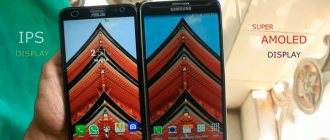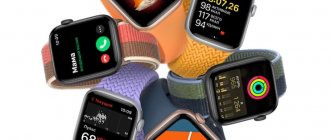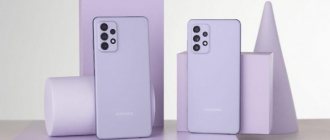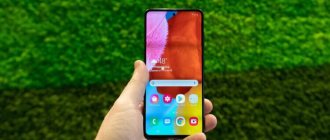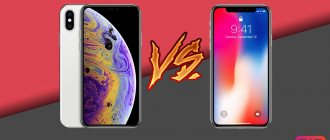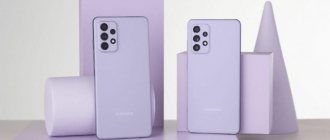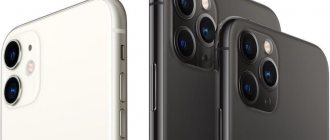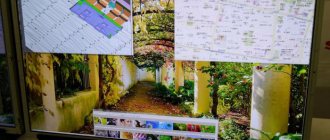IPS (In Plane Switching) is a high-quality liquid crystal matrix that was created to eliminate the main disadvantages of matrices based on TN technology (TN LCD).
The features of IPS matrices and their design can be useful to know when choosing a monitor, purchasing a new laptop, or replacing the matrix of an old one. IPS technology has some advantages over the more common and cheaper TN technology. All this will be discussed in the article.
Comparison of TN matrix and IPS
TN matrices were the first to appear in smartphones, so they are the most primitive. The main advantage of this technology is its low cost. The cost of a TN display is 50% lower compared to the cost of other technologies. Such matrices have a number of disadvantages: small viewing angles (no more than 60 degrees. If more, the picture begins to distort), poor color rendition, low contrast. The logic of manufacturers to abandon this technology is clear - there are a lot of shortcomings, and all of them are serious. However, there is one advantage: response time. In TN matrices the response time is only 1 ms, although in IPS screens the response time is usually 5-8 ms. But this is just one plus that cannot be weighed against all the minuses. After all, even 5-8 ms is enough to display dynamic scenes, and in 95% of cases the user will not notice the difference between response times of 1 and 5 ms. In the photo below the difference is clearly visible. Note the color distortion at angles on the TN matrix.
Unlike TN, IPS matrices show high contrast and have huge viewing angles (sometimes even maximum). This type is the most common, and they are sometimes referred to as SFT matrices. There are many modifications of these matrices, so when listing the pros and cons, you need to keep in mind a specific type. Therefore, below, to list the advantages, we will mean the most modern and expensive IPS matrix, and to list the disadvantages, the cheapest.
Pros:
- Maximum viewing angles.
- High energy efficiency (low energy consumption).
- Accurate color reproduction and high brightness.
- The ability to use high resolution, which will give a higher pixel density per inch (dpi).
- Good behavior in the sun.
Minuses:
- Higher price compared to TN.
- Distortion of colors when the display is tilted too far (however, viewing angles are not always maximum on some types).
- Oversaturation of color and insufficient saturation.
Today, most phones have IPS matrices. Gadgets with TN displays are used only in the corporate sector. If a company wants to save money, then it can order monitors or, for example, cheaper phones for its employees. They may have TN matrices, but no one buys such devices for themselves.
comparison table
| Name | Display size (inch) | Battery capacity (mAh) | RAM (GB) | Internal memory (GB) | Camera resolution (MP) | Average price (RUB) |
| Xiaomi POCO X3 Pro | 6,67 | 5160 | 8 | 256 | 48+8+2+2 | 21500 |
| Xiaomi POCO M3 | 6,53 | 6000 | 4 | 64 | 48+2+2 | 14000 |
| Xiaomi Redmi 9 | 6,53 | 5020 | 4 | 64 | 13+8+5+2 | 13500 |
| Vivo Y31 | 6,58 | 5000 | 4 | 128 | 48+2+2 | 16000 |
| HUAWEI P smart 2022 | 6,67 | 5000 | 4 | 128 | 48+8+2+2 | 16000 |
| Xiaomi Mi 10T Pro | 6,67 | 5000 | 8 | 256 | 108+13+5 | 46500 |
| Vsmart Joy 4 | 6,53 | 5000 | 4 | 64 | 16+8+2+2 | 13000 |
| OnePlus Nord N10 5G | 6,49 | 4300 | 6 | 128 | 64+8+2+2 | 21000 |
| Nokia G20 | 6,5 | 5050 | 4 | 128 | 48+5+2+2 | 14000 |
| Motorola Moto G9 Play | 6,5 | 5000 | 4 | 64 | 48+2+2 | 13500 |
Amoled and SuperAmoled screens
Most often, Samsung smartphones use SuperAMOLED matrices. This company owns this technology, and many other developers are trying to buy it or borrow it.
The main feature of AMOLED matrices is the depth of black color. If you put an AMOLED display and an IPS side by side, then the black color on the IPS will seem light compared to the AMOLED. The very first such matrices had implausible color reproduction and could not boast of color depth. Often there was so-called acidity or excessive brightness on the screen.
But developers at Samsung have corrected these shortcomings in SuperAMOLED screens. These have specific advantages:
- Low power consumption;
- Better picture compared to the same IPS matrices.
Flaws:
- Higher cost;
- The need to calibrate (set) the display;
- Rarely can the lifespan of diodes vary.
AMOLED and SuperAMOLED matrices are installed on the top flagships due to the best picture quality. Second place is occupied by IPS screens, although it is often impossible to distinguish between an AMOLED and an IPS matrix in terms of picture quality. But in this case, it is important to compare subtypes, and not technologies as a whole. Therefore, you need to be on guard when choosing a phone: often advertising posters indicate the technology, and not a specific matrix subtype, and the technology does not play a key role in the final quality of the picture on the display. BUT! If TN+film technology is indicated, then in this case it is worth saying “no” to such a phone.
Color quality
Color quality is another difference between TN panels and other types. There are two parameters that can be distinguished in monitors: color depth (or bit depth) and color range.
In these two parameters, TN panels are outsiders. Especially entry-level monitors only support 6-bit color and use frame rate control, also called FRC or simulated halftone, to achieve standard 8-bit color.
6-bit panels typically display color bands, while panels that natively support 8-bit light display smoother color transitions and produce higher-quality color results.
However, not all TN panels are 8-bit. High end monitors of this type are 8-bit, but still most of these monitors are 6-bit even these days. If you need an 8-bit monitor, it is better to choose an IPS or VA type, where there are many native 8-bit models.
Even now there are budget 6-bit IPS and VA panels, but in the mid- and high-end price categories they are 8-bit.
As for native 10-bit monitors, they are usually IPS. Similar VA panels are also found, but quite rarely. Most supposedly 10-bit monitors are actually 8-bit+FRC, and only expensive professional-grade monitors offer native 10-bit color.
Innovation
Removing the OGS air gap
Every year engineers introduce image enhancement technologies. Some of them are forgotten and not used, and some make a splash. OGS technology is just that.
Typically, a phone screen consists of protective glass, the matrix itself, and an air gap between them. OGS allows you to get rid of the extra layer - the air gap - and make the matrix part of the protective glass. As a result, the image appears to be on the surface of the glass, rather than hidden underneath it. The effect of improving display quality is obvious. Over the past couple of years, OGS technology has been unofficially considered a standard for any more or less normal phones. Not only expensive flagships are equipped with OGS screens, but also budget phones and even some very cheap models.
Screen glass bending
The next interesting experiment, which later became an innovation, is 2.5D glass (that is, almost 3D). Thanks to the curves of the screen at the edges, the picture becomes more voluminous. If you remember, the first Samsung Galaxy Edge smartphone made a splash - it was the first (or not?) to have a display with 2.5D glass, and it looked amazing. There is even an additional touch panel on the side for quick access to some programs.
HTC was trying to do something different. The company created the Sensation smartphone with a curved display. In this way it was protected from scratches, although it was not possible to achieve any greater benefit. Nowadays, such screens cannot be found due to the already durable and scratch-resistant protective glass Gorilla Glass.
HTC didn't stop there. The LG G Flex smartphone was created, which not only had a curved screen, but also the body itself. This was the “trick” of the device, which also did not gain popularity.
Stretchable or flexible screen from Samsung
As of mid-2022, this technology is not yet used in any phone available on the market. However, Samsung in videos and at its presentations demonstrates AMOLED screens that can stretch and then return to their original position.
Photo of a flexible display from Samsung:
The company also presented a demo video where you can clearly see the screen curving by 12 mm (as the company itself states).
It is quite possible that Samsung will soon make a very unusual revolutionary screen that will amaze the whole world. This will be a revolution in terms of display design. It's hard to imagine how far the company will go with this technology. However, perhaps other manufacturers (Apple, for example) are also developing flexible displays, but so far there have been no such demonstrations from them.
Final rating table
| Place | Name | Ya.Market |
| #1 | Xiaomi POCO X3 Pro | Buy |
| #2 | Xiaomi POCO M3 | Buy |
| #3 | Xiaomi Redmi 9 | Buy |
| #4 | Vivo Y31 | Buy |
| #5 | HUAWEI P smart 2022 | Buy |
| #6 | Xiaomi Mi 10T Pro | Buy |
| #7 | Vsmart Joy 4 | Buy |
| #8 | OnePlus Nord N10 5G | Buy |
| #9 | Nokia G20 | Buy |
| #10 | Motorola Moto G9 Play | Buy |
The best smartphones with AMOLED matrices
Considering that SuperAMOLED technology was developed by Samsung, it is mainly used in models from this manufacturer. In general, Samsung is a leader in the development of improved screens for mobile phones and TVs. We already understood this.
Today, the best display of all existing smartphones is the SuperAMOLED screen in the Samsung S8. This is even confirmed in the DisplayMate report. For those who don't know, Display Mate is a popular resource that analyzes screens inside and out. Many experts use their test results in their work.
To define the screen in the S8, we even had to introduce a new term - Infinity Display . It received this name due to its unusual elongated shape. Unlike its previous screens, Infinity Display has been seriously improved.
Here is a short list of benefits:
- Brightness up to 1000 nits. Even in bright sunshine, the content will be highly readable.
- A separate chip for implementing Always On Display technology. The already economical battery now consumes even less battery power.
- Picture enhancement function. In Infinity Display, content without an HDR component gains it.
- Brightness and color settings are automatically adjusted based on users' preferences.
- Now there is not one, but two lighting sensors, which more accurately allows you to automatically adjust the brightness.
Even compared to the Galaxy S7 Edge, which had a "reference" screen, the S8's display looks better (whites are truly white on it, while on the S7 Edge they go warmer).
But besides the Galaxy S8, there are other smartphones with screens based on SuperAMOLED technology. These are, of course, mostly models from the Korean company Samsung. But there are also others:
- Meizu Pro 6;
- OnePlus 3T;
- ASUS ZenFone 3 Zoom ZE553KL - 3rd place in the TOP of Asusu phones (located here).
- Alcatel IDOL 4S 6070K;
- Motorola Moto Z Play, etc.
But it is worth noting that although the hardware (that is, the display itself) plays a key role, software is also important, as well as minor software technologies that improve picture quality. SuperAMOLED displays are famous primarily for their ability to widely adjust temperature and color settings, and if there are no such settings, then the point of using these matrices is slightly lost.
Color range
Another area where VA and IPS screens have an advantage. The best TN panels are limited to the sRGB color range, and in the worst case, they don't even cover it all. TN panels with a wide color range are available, but they are rare.
VA panels typically offer at least full coverage of the sRGB color gamut and can go further. If film with quantum dots is used (usually Samsung panels), the color range is wider. It is around 125% sRGB or 90% DCI-P3. Most wide color gamut VA monitors have 85-90% DCI-P3 coverage, which is a decent result. A value of 95% or higher is even better.
The most variety is in IPS panels. Entry-level models offer 95% sRGB or less, although most provide full coverage of this color range. As for the high-end screens, usually for professional use, they can see the DCI-P3 and Adobe RGB color ranges.
Of all the wide color gamut IPS screens reviewed, the lowest DCI-P3 coverage was 93%, usually 95%. This makes IPS the best screen type for producing a wide color range.
Apple's Retina displays
Since we're talking about Samsung screens, it's appropriate to mention Apple's closest competitor and their Retina technology. And although Apple uses classic IPS matrices, they are distinguished by extremely high detail, large viewing angles and good detail.
A feature of Retina displays is the ideal diagonal/resolution ratio, thanks to which the picture on the screen looks as natural as possible. That is, there are no individual pixels that are visible on screens with low resolution. At the same time, there is not even the unpleasant sharpness that can sometimes be seen on displays with excessively high resolution.
But in fact, Retina Display is based on a regular IPS matrix, so Apple has not created anything fundamentally new and revolutionary with these screens. It just made the already good IPS technology a little better.
Please rate the article:
Join on Telegram
